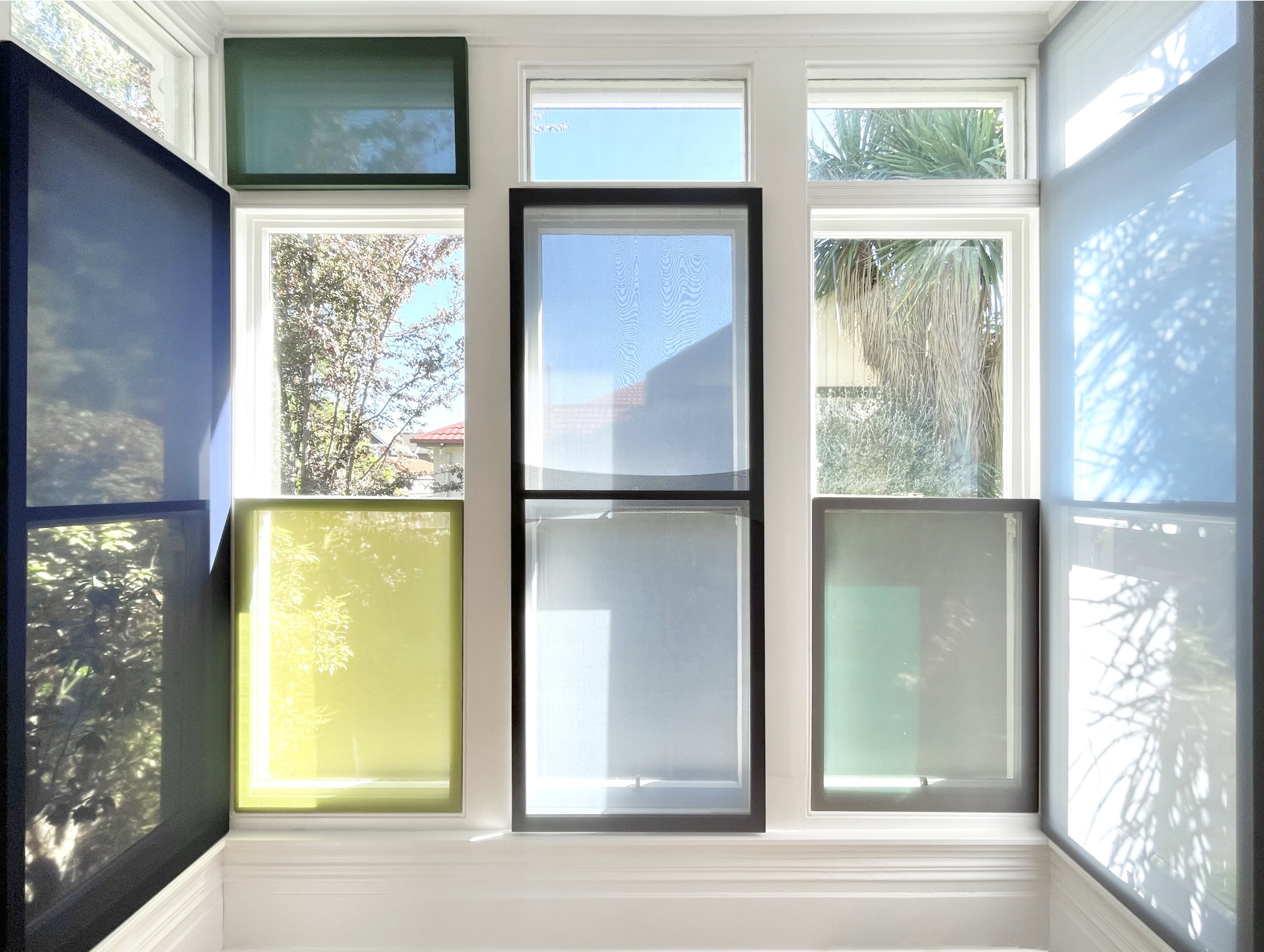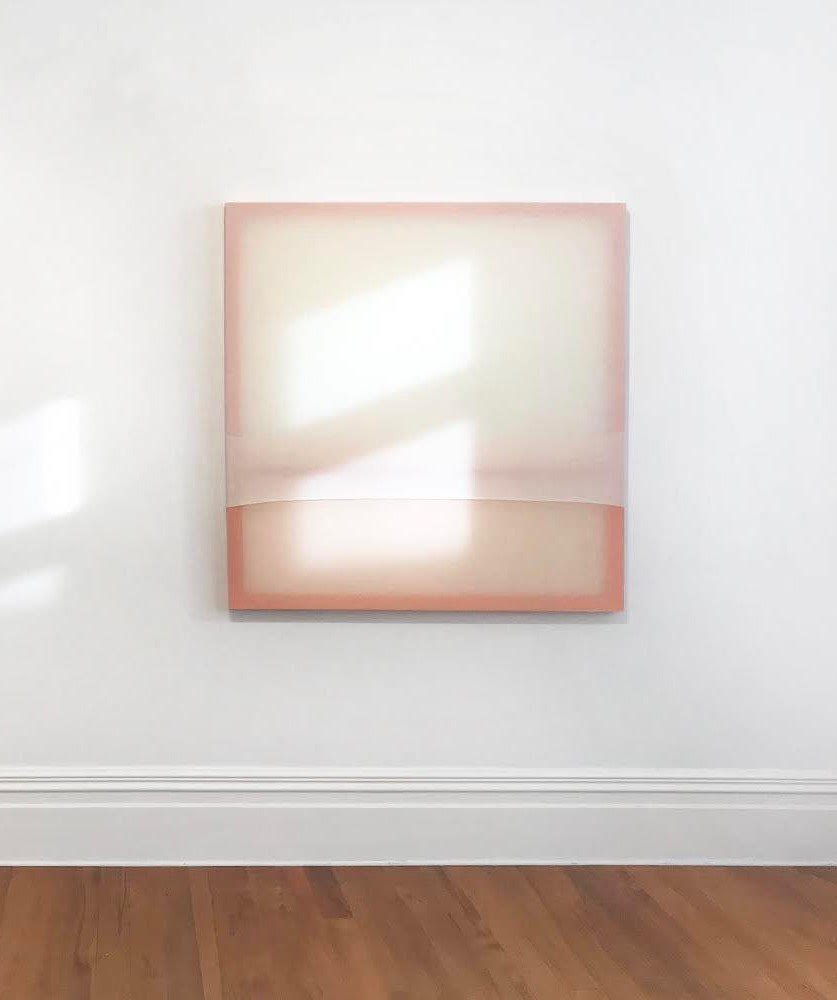Casting shadows in space
Hannah Crichton speaks to Polly Gilroy about her recent exhibition, Traces.
Polly Gilroy, Traces. Installation view, PG gallery192, Christchurch, May 2022
I suppose I’ll start at the beginning. A lot of my university practice was abstract painting. What shaped the stretch material works—which are what I do now—was an art trip to New York organised by Massey University when I was a student.
I was already incorporating material into my works by putting silks onto canvases and playing with the texture. In New York I started thinking about what painting is, how we define it. It was the first time I had been able to see, first hand, works by [people such as] Richard Tuttle and Rodney McMillan, who produced constructed fabric works; which shifted my perception that paintings involve paint.
On my return, I began making site-specific works at Massey, replicating the shapes thrown by cast shadows or the colours I saw outside the window. I also started experimenting with putting works on the wall versus in windows. Traces investigates this further.
Hannah Crichton: Can you explain why you settled on Traces as a title, and what the stimulus behind the exhibition was?
Polly Gilroy: My last exhibition at PG, In Absence Of, included big shadows cast from the window that became pivotal in my wider practice. I later made the traces of shadow more permanent by turning them into actual works, and used windows as a means to display certain works too. Each piece of architecture in Traces—including door frames and windows—is an important part of the exhibition.
Your artworks, which utilise nuanced hues and translucent silks, evoke a sense of rumination and fleetingness. I am reminded of natural phenomena, or changes of state in nature—sunrises and sunsets, mist over water, and disappearing horizons. Can you explain your art practice?
Exactly that. I’m always taking photos of interesting cast shadows and looking at ways to recreate these compositions. I’m interested in windows framing an experience, which can be turned into something more permanent. I want to (re)create a familial aesthetic that reminds viewers of something.
Like a touchstone?
Yes! I want to create something that engages the viewer in their environment, architecturally and emotionally.
Can you expand on how light is utilised in Traces, and how you came to examine the relationship between light and shadow?
Where Shadow Chases Light, my graduate exhibition at Massey, was what led me to this relationship. I was thinking about transparency and how light was cast through the fabric. My window installations in Traces create a muted viewing portal , and allow the work to be accessed from all sides. Light passing through offers a depth that shifts; and doesn’t happen with my wall-mounted pieces.
One of the most integral components of this exhibition is the sun. The window works turn into drawings throughout the day; they change depending on the weather. On a sunny day there are square shadow reflections of shimmering trees, whereas a cloudy day is more moody.
Colour is essential to your practice. Previous works have thrummed with a seemingly natural glow, hence my likening your works to changes of state in nature. Can you expand on your use of colour, particularly the nuanced hues; and how Traces examines the perception of depth?
Over the last couple of years I have been exploring how separate layers can change the colour of a work, and how light can also impact this. Multiple tonal layers create different colours. I often play with the tones of the inner frame and backing, creating a complete shift of colour once the work is finished and the fabric is in place.
I explore how to layer colours to make the fabric glow—so you’re looking at the work and beyond the work. Often, when you get close to my work, you can’t see where it ends. The silk conceals all of the secrets.
And are you inspired by stained glass windows?
Yes. I have many photos of stained glass windows that inspire me.
Typically, your artworks are square. Traces signals a departure from this norm. The works are slanted angles, akin to panes of glass.
When windows cast shadows on walls they’re often the shape of the window, but skewed and extended at one end. I’m constantly trying to question how we recognise something as a painting and push the formal boundaries of this, whilst finding ways to heighten our awareness of the surrounding space or architecture.
PG gallery192 often offers a platform to emerging contemporary artists. Your dual position as a gallery manager and (occasional) exhibiting artist offers a unique perspective on how vital artist-run initiatives are.
Any artist-run-initiative is important, especially to younger, emerging artists, as these spaces enable the sector to grow and be nurtured at a greater pace. PG is a dealer gallery, artist-directed by Marian Maguire alongside Nigel Buxton, and allows space for artists to explore their practice within a commercial framework. Christchurch has, historically, had some amazing ARIs, and I hope more will pop up soon.
Polly Gilroy, Traces. Installation view, PG gallery192, Christchurch, May 2022
Polly Gilroy, Traces. Installation view, PG gallery192, Christchurch, May 2022
Polly Gilroy, Traces. Installation view, PG gallery192, Christchurch, May 2022
Polly Gilroy, Traces, continues at PG gallery192 through 20 May 2022.















Hannah Crichton speaks to Polly Gilroy about her recent exhibition, Traces.